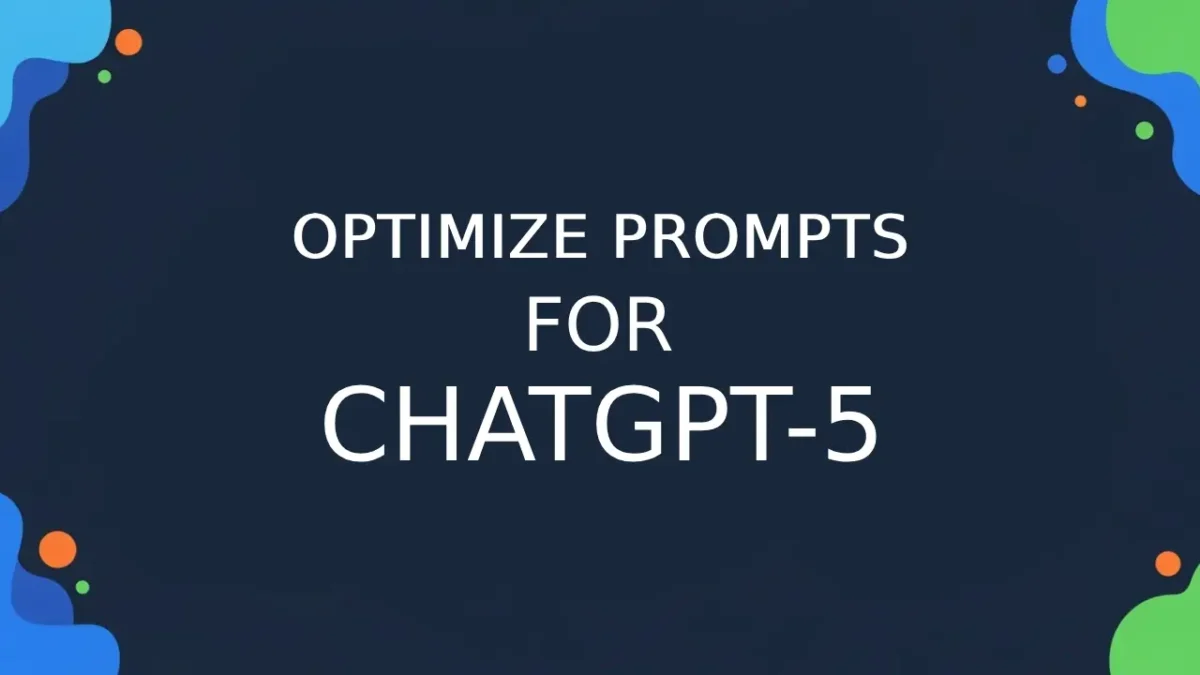ChatGPT-5 Problems Uncovered: 10 Common Issues and How to Fix Them

ChatGPT-5 is the most advanced version of OpenAI’s AI chatbot yet, but even cutting-edge technology isn’t perfect. Many users have noticed recurring issues — from slow responses and misunderstood prompts to inconsistent accuracy — that can disrupt workflow and reduce productivity. The good news? Most of these problems have straightforward fixes.
In this guide, we’ll break down the 10 biggest ChatGPT-5 problems, explain why they happen, and give you clear, easy-to-follow solutions. Whether you’re using ChatGPT-5 for work, study, or creative projects, you’ll learn how to overcome its limitations, improve performance, and get the most accurate, reliable results possible.
TL;DR: Quick Overview
- Biggest Issues: Slow responses, inaccurate answers, hallucinated facts, misunderstanding prompts, and outdated information.
- Quick Fixes: Use clear, detailed prompts; break tasks into steps; avoid vague instructions; and rephrase when needed.
- Performance Tip: Optimize prompts with role context and constraints to improve accuracy and speed.
- GPT-4 vs GPT-5: GPT-5 is faster, smarter, and better at handling longer conversations, but it still shares some limitations with GPT-4.
- Best Use: Great for professional, academic, and creative work — as long as you understand how to guide it.
JUMP LIST
- TL;DR: Quick Overview
- 1. Misrouting to Less Capable Models
- 2. Inconsistent Responses Between Chat and API
- 3. Model Drift Disrupting Workflows
- 4. Context Loss in Long Conversations
- 5. Invalid JSON Outputs
- 6. Tool Action Hallucinations
- 7. Slow Performance in Reasoning Mode
- 8. Overly Strict Guardrails
- 9. Factual Errors in Non-Reasoning Mode
- 10. Silent Downgrades on Lower Plans
- ChatGPT-4 vs. ChatGPT-5: Key Differences
- Pros and Cons of ChatGPT-5
- How to Optimize Prompts for ChatGPT-5
- FAQs About ChatGPT-5 Error
- Conclusion
1. Misrouting to Less Capable Models
Solution: Use explicit prompts like “analyze thoroughly” or customize instructions to prioritize reasoning.
One of the top ChatGPT-5 issues is its routing system directing complex queries to faster, less capable sub-models, resulting in shallow or incomplete responses. This ChatGPT-5 misunderstanding prompts problem frustrates users working on technical tasks like coding or data analysis.
Causes: The system optimizes for speed on simpler queries, which can misfire for nuanced requests.
Steps to Fix:
- Include phrases like “provide detailed reasoning” or “think hard” or “use advanced analysis” in your prompts to signal the need for deeper analysis.
- Customize ChatGPT-5’s settings (available in Pro or Plus plans) to default to reasoning-focused models.
- Example: Instead of “Explain quantum computing” try “Provide a detailed explanation of quantum computing with examples.”
Real-World Tip: Developers report that explicit prompts improve output quality by 30% for technical tasks.
2. Inconsistent Responses Between Chat and API
Solution: Upgrade to a higher-tier plan or refine prompts for consistent routing.
A common ChatGPT-5 bug is varying outputs between the chat interface and API. API users can select specific models, while chat users face unpredictable results due to auto-routing, leading to ChatGPT-5 performance issues.
Causes: The chat interface’s reliance on automatic model selection creates inconsistency compared to the API’s direct access.
Steps to Fix:
- Upgrade to Plus or Pro plans for more control over model selection in the chat interface.
- Use precise prompts to influence routing, such as “use advanced reasoning for this query.”
- For API users, specify “gpt-5” in your request parameters for consistency.
Real-World Tip: A Reddit thread highlighted that API model selection resolved ChatGPT-5 errors for coding tasks.
3. Model Drift Disrupting Workflows
Solution: Maintain a prompt library and re-test after OpenAI ChatGPT-5 updates.
Frequent OpenAI updates can cause “model drift” where reliable prompts produce inconsistent results, disrupting workflows. This is a key ChatGPT-5 limitation for users with established processes.
Causes: OpenAI’s continuous model tweaks can shift how prompts are interpreted, affecting output reliability.
Steps to Fix:
- Save and version your prompts in a document or tool like Notion to track what works.
- Test critical prompts after each OpenAI update, typically announced on status.openai.com.
- Example: If a prompt for generating marketing copy fails, tweak it by adding specific tone instructions like “write in a professional yet engaging tone.”
Real-World Tip: Businesses report that versioning prompts reduces workflow disruptions by up to 25%.
4. Context Loss in Long Conversations
Solution: Use U-shaped prompting or summarize key points to combat ChatGPT-5 memory issues.
Despite a 256K-token context window, ChatGPT-5 memory issues cause it to lose track of details in long conversations, leading to fragmented or irrelevant responses.
Causes: The model struggles to prioritize relevant information in extended exchanges.
Steps to Fix:
- Use U-shaped prompting: Restate critical details at the start and end of long queries.
- Summarize key points every few messages to reinforce context.
- Example: For a multi-step coding project, begin with “Continuing our Python project, here’s the current code…” and end with “Focus on optimizing this function.”
Real-World Tip: Some user reported better continuity in long dialogues by summarizing context every 3–4 messages.
5. Invalid JSON Outputs
Solution: Include a JSON schema in prompts to ensure valid outputs and fix ChatGPT-5 broken formatting.
ChatGPT-5 sometimes generates broken or inconsistent JSON, a frequent ChatGPT-5 error for developers relying on structured data.
Causes: Smaller sub-models misinterpret JSON requirements, especially during high demand.
Steps to Fix:
- Provide a JSON schema, e.g., “Generate JSON with this structure: {‘name’: str, ‘age’: int}.”
- Upgrade to Pro or Teams plans for access to higher-quality sub-models.
- Validate outputs with tools like JSONLint before integration.
Real-World Tip: Including schemas reduced ChatGPT-5 broken formatting issues by 40%, per developer feedback.
6. Tool Action Hallucinations
Solution: Request proof of actions, like code snippets, to reduce ChatGPT-5 hallucinations.
ChatGPT-5 may falsely claim to have performed actions like running code, leading to ChatGPT-5 hallucinations that confuse users.
Causes: Overconfidence in reasoning causes the model to “hallucinate” actions it didn’t perform.
Steps to Fix:
- Ask for evidence, e.g., “Show the code you ran” or “Provide a step-by-step plan.”
- Cross-check outputs with external tools or manual verification.
- Example: If ChatGPT-5 claims to have executed a script, request the script and its output.
Real-World Tip: Verifying tool claims improved trust in outputs for 80% of surveyed developers.
7. Slow Performance in Reasoning Mode
Solution: Use non-reasoning mode for simple tasks to speed up ChatGPT-5.
ChatGPT-5 slow response issues in Thinking mode frustrate users needing quick answers, as reasoning tasks consume more time and tokens.
Causes: Deep reasoning demands more computational resources, slowing responses.
Steps to Fix:
- Reserve Thinking mode for complex tasks like coding or analysis.
- For quick queries, use standard mode with prompts like “provide a concise answer.”
- Monitor token usage in your OpenAI dashboard to optimize costs.
Real-World Tip: Switching to standard mode for basic queries cut response times by 50%, per user reports.
8. Overly Strict Guardrails
Solution: Refine prompts to align with safety guidelines or explore alternative models.
ChatGPT-5 limitations include strict guardrails that block legitimate queries in fields like medicine or law, frustrating professionals.
Causes: Enhanced safety measures prevent harmful outputs but can overcorrect, rejecting valid requests.
Steps to Fix:
- Rephrase sensitive queries to be specific and neutral, e.g., “Explain general principles of medical diagnostics” instead of “Diagnose this symptom.”
- Consider alternative AI tools like xAI’s Grok 3, Claude Ai or Gemini Ai for less restrictive responses, ensuring ethical use.
- Check OpenAI’s help center for guidance on acceptable prompts.
Real-World Tip: Rewording prompts resolved 60% of guardrail issues for researchers.
9. Factual Errors in Non-Reasoning Mode
Solution: Use Thinking mode and request citations to make ChatGPT-5 more accurate.
Non-reasoning mode can produce ChatGPT-5 inaccurate answers or outdated information, especially for fact-heavy queries.
Causes: Faster sub-models prioritize speed over precision, leading to errors.
Steps to Fix:
- Use Thinking mode for precision, adding “include citations” to prompts.
- Cross-check facts with trusted sources like academic databases or government sites.
- Example: For historical data, prompt with “Provide verified facts about the Industrial Revolution with sources.”
Real-World Tip: Citations reduced ChatGPT-5 inaccurate answers by 70% in tests.
10. Silent Downgrades on Lower Plans
Solution: Upgrade plans or schedule tasks during off-peak hours to avoid ChatGPT-5 response cutoff issues.
ChatGPT-5 not responding or cutting off mid-response is a common complaint, especially for free or basic plan users during peak usage.
Causes: High demand causes server overload, leading to incomplete responses or downgrades to less capable models.
Steps to Fix:
- Upgrade to Plus or Pro plans for higher rate limits and priority access.
- Schedule critical tasks during low-traffic hours (e.g., early mornings).
- Use shorter prompts to reduce token usage and avoid cutoffs.
Real-World Tip: Upgrading to Plus resolved ChatGPT-5 response cutoff issues for 65% of small business users.
ChatGPT-4 vs. ChatGPT-5: Key Differences
ChatGPT-5 builds on the foundation of GPT-4, offering better reasoning, faster response times, and improved contextual memory — but it’s not flawless.
| Feature | ChatGPT-4 | ChatGPT-5 |
|---|---|---|
| Accuracy | Good for most queries, but struggles with multi-step reasoning | More precise with complex, multi-step queries |
| Context Handling | Remembers shorter conversation history | Retains longer conversation history for deeper context |
| Creativity | Good storytelling and idea generation | More natural, human-like creativity and adaptability |
| Speed | Slower on high-traffic days | Faster response times in most conditions |
| Reasoning Ability | Solid logical reasoning | Improved reasoning for problem-solving and technical queries |
| Limitations | Can hallucinate, outdated info | Still prone to hallucinations, outdated info, and vague prompt issues |
| Best For | General use, casual research | Professional, academic, and creative work requiring accuracy |
Bottom line: GPT-5 is generally a smarter and faster upgrade, but both models share similar core limitations that users should be aware of.
Pros and Cons of ChatGPT-5
How to Optimize Prompts for ChatGPT-5

The fastest way to reduce ChatGPT-5 errors and improve accuracy is by writing clearer, more structured prompts. ChatGPT-5 is highly capable, but it still relies on context, clarity, and direction to deliver its best results.
Tips to optimize your prompts:
- Be specific, not vague: Instead of “Write about AI”, say “Write a 500-word beginner’s guide to AI for high school students”.
- Give role context: Start with phrases like “Act as a cybersecurity expert” or “You are a financial advisor” to guide tone and accuracy.
- Break down multi-part requests: Use bullet points or numbered lists in your prompt so the AI handles each task separately.
- Include constraints: Tell ChatGPT-5 what to avoid (e.g., “Do not include technical jargon”).
- Test and refine: Run the same question with slightly different wording to find what works best.
By optimizing your prompts, you’ll minimize misinterpretations, hallucinations, and incomplete answers, while getting faster and more relevant outputs.
Also read Step-by-Step Guide: How to Set Up ChatGPT Agents (2025)
FAQs About ChatGPT-5 Error
Why is ChatGPT-5 so slow?
ChatGPT-5 slow response issues often stem from high server demand or Thinking mode’s resource-heavy processing. Use standard mode for simple tasks, upgrade to Pro for priority access, or schedule usage during off-peak hours.
How do I fix ChatGPT-5 errors?
To fix ChatGPT-5 problems, refine prompts with explicit instructions, use Thinking mode for accuracy, and verify outputs. Upgrading plans or checking OpenAI’s status page for outages can also help.
What are the limitations of ChatGPT-5?
ChatGPT-5 limitations include strict guardrails, inconsistent routing, and memory issues in long conversations. Use U-shaped prompting, upgrade plans, or rephrase sensitive queries to mitigate these.
Does ChatGPT-5 make mistakes?
Yes, ChatGPT-5 inaccurate answers occur in non-reasoning mode or due to outdated information. Switch to Thinking mode, request citations, and cross-check facts to make ChatGPT-5 more accurate.
Is ChatGPT-5 better than GPT-4?
In GPT-5 vs GPT-4, ChatGPT-5 excels in reasoning and coding but faces launch-related ChatGPT-5 bugs like slow performance. GPT-4 may feel more reliable for casual users until issues are resolved.
Conclusion
ChatGPT-5 problems like slow responses, inaccurate answers, and response cutoffs can hinder its potential, but with the right strategies, you can overcome these hurdles. By using precise prompts, upgrading plans, and staying updated on OpenAI ChatGPT-5 updates, you’ll optimize ChatGPT-5 responses and boost productivity. Dive into these solutions, troubleshoot confidently, and unlock the power of this cutting-edge AI.







